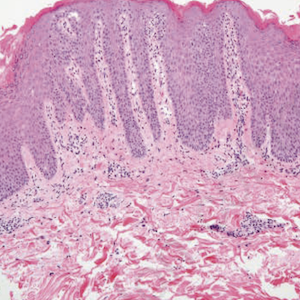Implications of interleukin-17 in psoriatic lesions as Koebner phenomenon caused by recurrent occupational burns
 Smart Citations
Smart CitationsSee how this article has been cited at scite.ai
scite shows how a scientific paper has been cited by providing the context of the citation, a classification describing whether it supports, mentions, or contrasts the cited claim, and a label indicating in which section the citation was made.
The Koebner phenomenon (KP) is the emergence of new lesions in an uninvolved skin area caused by different types of stimulations, including mechanical stress, chemical stress, trauma, or injury. KP affects patients with certain skin diseases and is frequently observed in patients with psoriasis. We report the case of a 43-year-old obese male welder who developed psoriatic lesions only in areas of repeated burns due to his occupation. He was repeatedly exposed to mild burns in his anterior neck and the periorbital region as he was welding without shield protection. Subsequently, erythema appeared in the same region. Skin appearance and skin biopsy suggested psoriasis vulgaris (PV), and immunohistochemical analysis of anti-interleukin (IL)-17, a crucial element in the development of PV, showed the positivestained cells. The anti-IL-17 staining was prominent around the thickened epidermis as psoriatic lesions. IL-17 produced by T helper 17 cells stimulates keratinized cells and promotes chemokine secretion involved in neutrophil migration. Our case showed that patients, even without a history of PV, may have a risk of developing KP and PV via the enhanced production of IL- 17 locally in the repeated burn area. No recurrence of skin symptoms was observed when the patient used a fully defensive shield during welding.





 https://doi.org/10.4081/dr.2022.9567
https://doi.org/10.4081/dr.2022.9567





